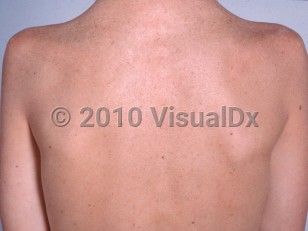Cockayne syndrome (CS) is a rare autosomal recessive multisystem disorder that presents with a constellation of findings including photosensitivity, growth retardation, and progressive neurologic deterioration. Patients with CS can be classified into 3 types depending on their age of onset and severity of disease. CS type I affects 80% of CS patients with onset of symptoms at birth to 2 years of age and life expectancy in the second to third decades. CS type II has symptoms at birth with a life span of only 5-6 years. CS type III has a late onset with first symptoms presenting at 3-4 years of age and mild subtype with mean age of death at 30 years.
An early finding in patients with CS is growth retardation followed by deafness, loss of subcutaneous fat, and eventually cachexia, giving this syndrome its characteristic physical stigmata of a "cachectic dwarf."
Common additional findings include cataracts, progressive pigmentary retinopathy, dental caries, photosensitivity, and neurodevelopmental changes including white matter involvement. Early presentation with cataracts (ie, prior to age 3) in patients with CS seems to be associated with a more severe phenotype. Cause of death in patients with CS is variable. The leading cause of death is respiratory infection.
CS, like xeroderma pigmentosum (XP) and trichothiodystrophy, is a nucleotide excision repair disorder. In contrast to XP, skin cancers on sun-exposed areas are not observed in patients with CS. However, a dozen affected patients with clinical features of both CS and XP have been described and these patients are at high risk for the development of cutaneous neoplasms due to failure of DNA excision repair gene.
Cockayne syndrome in Adult
Alerts and Notices
Important News & Links
Synopsis

Codes
ICD10CM:
Q87.19 – Other congenital malformation syndromes predominantly associated with short stature
SNOMEDCT:
21086008 – Cockayne syndrome
Q87.19 – Other congenital malformation syndromes predominantly associated with short stature
SNOMEDCT:
21086008 – Cockayne syndrome
Look For
Subscription Required
Diagnostic Pearls
Subscription Required
Differential Diagnosis & Pitfalls

To perform a comparison, select diagnoses from the classic differential
Subscription Required
Best Tests
Subscription Required
Management Pearls
Subscription Required
Therapy
Subscription Required
References
Subscription Required
Last Reviewed:04/12/2018
Last Updated:01/12/2022
Last Updated:01/12/2022

